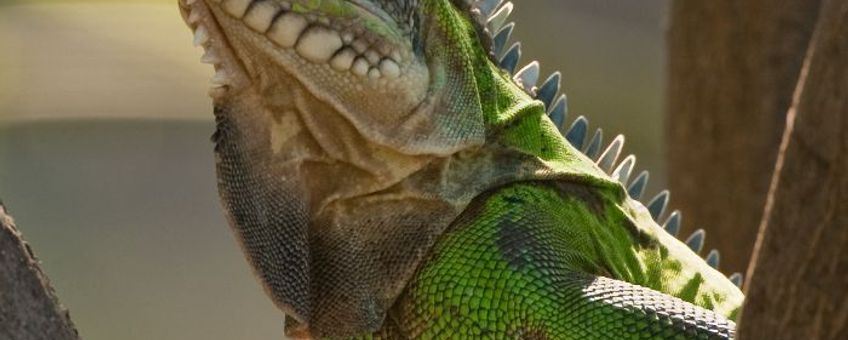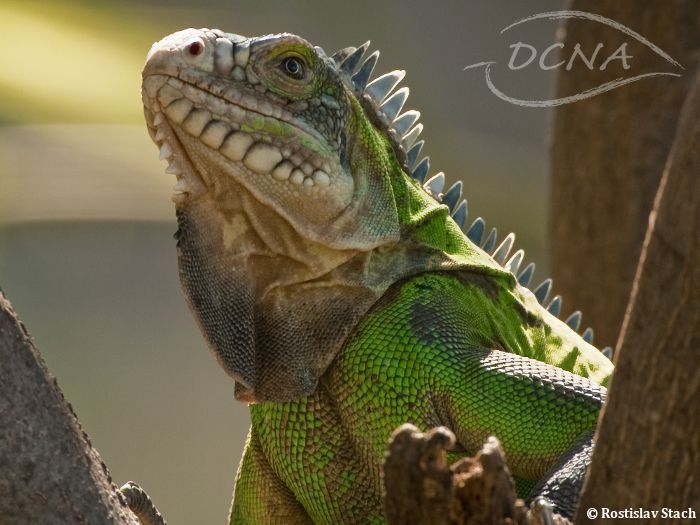
Antilliaanse leguaan met uitsterven bedreigd
Bericht uitgegeven door Dutch Caribbean Nature Alliance (DCNA) [land] op [publicatiedatum]
De Antilliaanse leguaan Iguana delicatissima wordt met uitsterven bedreigd. Eens kwam de leguaan verspreid over de Kleine Antillen voor: van het eilandje Anguilla tot het eiland Martinique. De populaties zijn echter snel kleiner geworden. Momenteel wordt de leguaan op nog maar 13 eilanden gevonden. Alleen op de eilanden Dominica en Guadeloupe bestaat de populatie nog uit meer dan 5000 individuen, het minimale aantal dat nodig is om op lange termijn een gezonde populatie in stand te houden. Op zes eilanden staat I. delicatissima op het punt van uitsterven; de soort staat ook op de IUCN Rode Lijst van met uitsterven bedreigde dieren. Sint Eustatius is het enige Nederlands Caribische eiland waar de Antilliaanse leguaan nog voorkomt. Naar schatting leven er een paar honderd individuen. Hiermee heeft Nederland de verantwoordelijkheid over één van de laatst overgebleven populaties. Gebrek aan nestgelegenheid, verstrikking in omheining en honden vormen de grootste gevaren voor de leguaan.
Lees verder in het Engels.....
The Lesser Antillean Iguana (Iguana delicatissima) was once found throughout the Lesser Antilles, ranging from Anguilla to Martinique, but population sizes have been subject to a rapid decline. Nowadays, the Lesser Antillean Iguana is found on only 13 islands in the region, with St. Eustatius being its last refuge within the Dutch Caribbean, hence its listing on the IUCN Red List as an Endangered Species facing extinction. Of these 13 island populations, only two exceed the long-term minimum viable population size of 5,000 individuals (Dominica and Guadeloupe) and on six the species is on the brink of extinction.

Mainly due to the fact that its “big brother” the Green Iguana (I.iguana) has not been introduced on St. Eustatius, the Netherlands now have the responsibility over one of the last surviving, potentially viable and genetically pure populations of the Lesser Antillean Iguana, which emphasizes the international responsibility to conserve this endangered reptile.
Until recently, St. Maarten was also home to a population of this striking, bright-green miniature dragon, but due to the introduction in the mid-90s of the Green Iguana, that population has seized to exist. The larger and more aggressive Green Iguana not only out-competes its smaller relative, but because the species are so closely related genetically, they can interbreed creating “hybrid” species. This forms a major threat to preserving the integrity of the species.
The Lesser Antillean Iguana and the Green Iguana can be most easily distinguished by the large subtympanic scale that can be found under the jaw on the cheeks and the unmistakable black and green banding of the tail, both typical features of the Green Iguana.
Population sizes for the Lesser Antillean Iguana on St. Eustatius have been estimated in the past at around a few hundred individuals, which is already far below the minimum viable population size. Recent research by IMARES Wageningen UR and the St. Eustatius National Parks (STENAPA) has indicated that since the last survey in 2004 population densities have declined across all habitats on the island and certain populations on St. Eustatius have even disappeared completely. Population densities vary from 0.0 to 2.0 with an average of 0.35 iguanas per square hectare, which is less than one percent of the average densities of healthy populations documented elsewhere.
On St. Eustatius, human hunting is likely a minor problem, shelter and food availability on the island are abundant, invasive predator densities in the wild are relatively low and we know the Green Iguana has not yet invaded. So what can be the cause for the population decline? Lesser Antillean Iguanas need nesting sites that are un-lit, barren, sandy and well-drained, a prerequisite that appears to be limited on St. Eustatius.
Furthermore, the majority of deaths or endangerments of iguanas on St. Eustatius are attributable to anthropogenic causes, mostly in gardens getting entangled in fences or trapped and molested by dogs. So it seems that the lack of nesting sites and high iguana mortalities due to anthropogenic causes are the two core factors limiting recovery of the Lesser Antillean Iguana on St. Eustatius.
Management recommendations
To counter this negative trend a few measures could be implemented for better protection of the wild population: training of customs officials to prevent potential entry of the mongoose and the Green Iguana from neighbouring islands will help ensure these serious threats do not make their way to St. Eustatius; improving enforcement and updating protective legislation will create a supportive legal framework for protection; the development and maintenance of new nesting habitat, a measure that is both easy and inexpensive, and the establishment of a programme to promote “iguana-friendly” gardens will alleviate pressure off the two greatest threats for the Lesser Antillean Iguana on St. Eustatius.
Efforts need to also be relaunched to determine if the Saba Black Iguana, currently seen as an ecotype of the Green Iguana, is genetically distinct or similar to other subspecies in the region, like the St. Lucia Iguana, whose taxonomic status is currently unresolved. Depending the outcome of this research, it could leverage further protection of the iguanas on Saba.
More scientific insight is still needed in the critical biological parameters that limit the recovery of the Lesser Antillean Iguana on St. Eustatius. An on-island husbandry and breeding project could potentially play a crucial role in the survival of the Lesser Antillean Iguana and would increase public awareness for the current status of the species by providing a relaxed setting in which the local community can experience the iguana as the gentle and beautiful animal that it is.
Credits
This project was part of the Wageningen University BO research programme (BO-11-011.05-004) and was financed by the Dutch Ministry of Economic Affairs, Agriculture and Innovation (EL&I).
Text: DCNA
Picture: Rostislav Stach
Nederlandse inleiding: Sara Mulder, De Natuurkalender
